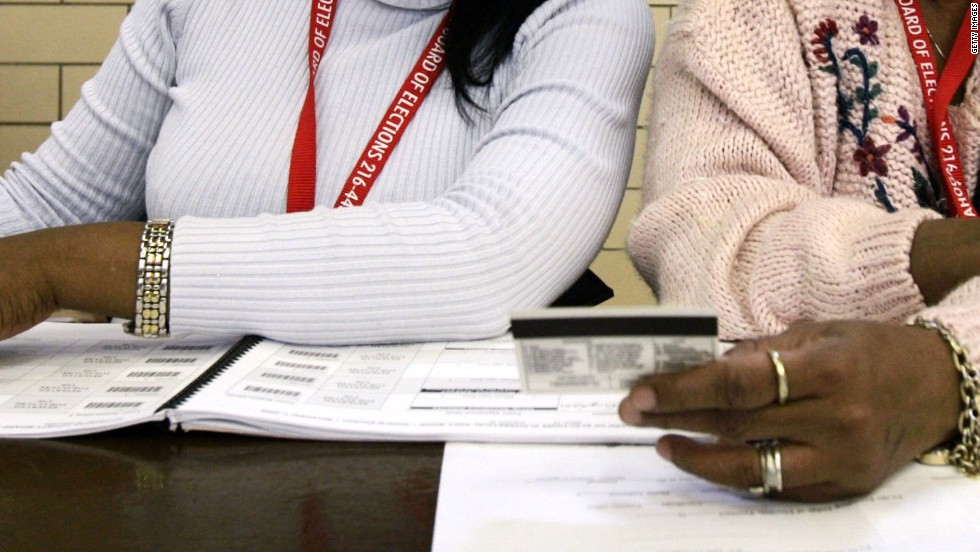Texas
election officials can go ahead and enforce a controversial voter
identification law opposed by the Obama administration and civil rights
groups, the U.S. Supreme Court said early Saturday.
The decision comes just two days before early voting begins in the state.
U.S. Attorney General Eric Holder said it was "a major step backward to let stand a law...(that was) designed to discriminate."
"It
is true we are close to an election," Holder said Saturday, "but the
outcome here that would be least confusing to voters is the one that
allowed the most people to vote lawfully.
A civil rights leader reacted harshly to the ruling, calling it an "affront to our democracy."
"Today's
decision means hundreds of thousands of eligible voters in Texas will
be unable to participate in November's election because Texas has
erected an obstacle course designed to discourage voting," said
Sherrilyn Ifill, president of the NAACP Legal Defense Fund.
A spokeswoman for the Texas attorney general's office, however, lauded the decision.
"We
are pleased that the U.S. Supreme Court has agreed that Texas' voter ID
law should remain in effect for the upcoming election," spokeswoman
Lauren Bean said.
"The state will continue to defend the voter ID law
and remains confident that the district court's misguided ruling will be
overturned on the merits.
The U.S. Supreme Court has already ruled that
voter ID laws are a legal and sensible way to protect the integrity of
elections."
While the court offered no
reasoning for its decision, it backs up a federal appeals court ruling
Tuesday saying that voting procedures shouldn't be upended so close to
the election.
That decision came in
response to a federal judge's ruling after a nine-day trial that a Texas
law requiring voters to show photo ID at the polls is unconstitutional.
"The
Supreme Court has repeatedly instructed courts to consider the
importance of preserving the status quo on the eve of an election," the
U.S. Court of Appeals for the Fifth Circuit said.
Proponents
say the law will help prevent voter fraud. Critics say such practices
make it harder for poor, minority and disabled people to vote.
Minority and civil rights groups who banded together to oppose the law said it was among the most restrictive in the nation.
Some
600,000 people in Texas lack state-issued IDs, according to the U.S.
Justice Department -- which rejected the law as a violation of the
Voting Rights Act.
Nationwide, the NAACP says 25% of African-Americans and 16% of Latinos of voting age lack a current government-issued photo ID.
Saturday's
decision doesn't speak to the constitutionality of the law--only
whether it can be enforced in this fall's election. Continued legal
challenges are a certainty, Ifill said.
While
the court's majority didn't offer any explanation for the ruling,
Justice Ruth Bader Ginsburg wrote a nearly seven-page dissent, joined by
Justices Sonia Sotomayor and Elena Kagan.
Ginsburg
said the costs associated with the law--obtaining identity cards and
the documents needed to get them--aren't as insignificant as backers
claim, and argued they harken back to the use of the poll tax in the
late 1800s and early 1900s as a method of preventing blacks from voting.
"The
greatest threat to public confidence in elections in this case is the
prospect of enforcing a purposefully discriminatory law, one that likely
imposes an unconstitutional poll tax and risks denying the right to
vote to hundreds of thousands of eligible voters," Ginsburg wrote.
The
first day of early voting in Texas is Monday.
Voters will choose a new
governor to replace outgoing Gov. Rick Perry, new lieutenant governor,
and new attorney general, in addition to voting on one of the state's
U.S. Senate seats and several House districts.
There is only negligible (extremely few cases) of voter fraud in Texas or in any of the remaining states. Some people (Republicans) think by using voter fraud as the rationale, that it will knock a large segment of Democratic voters in Texas clear off the rolls. Their plan is Orwellian.
How was voter integrity achieved in the past? How was it measured? Why has it worked for the last two hundred plus years?


<< Home